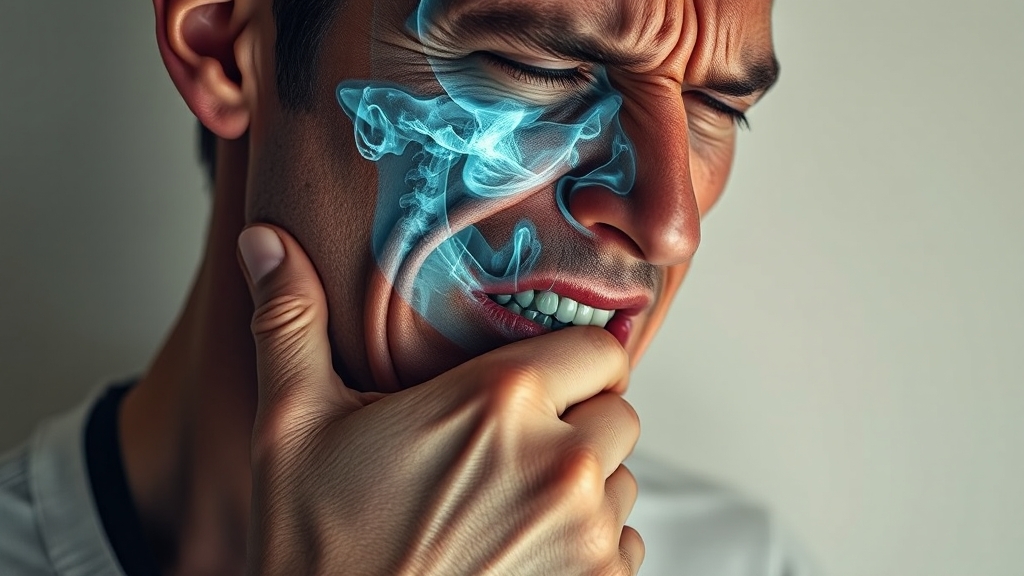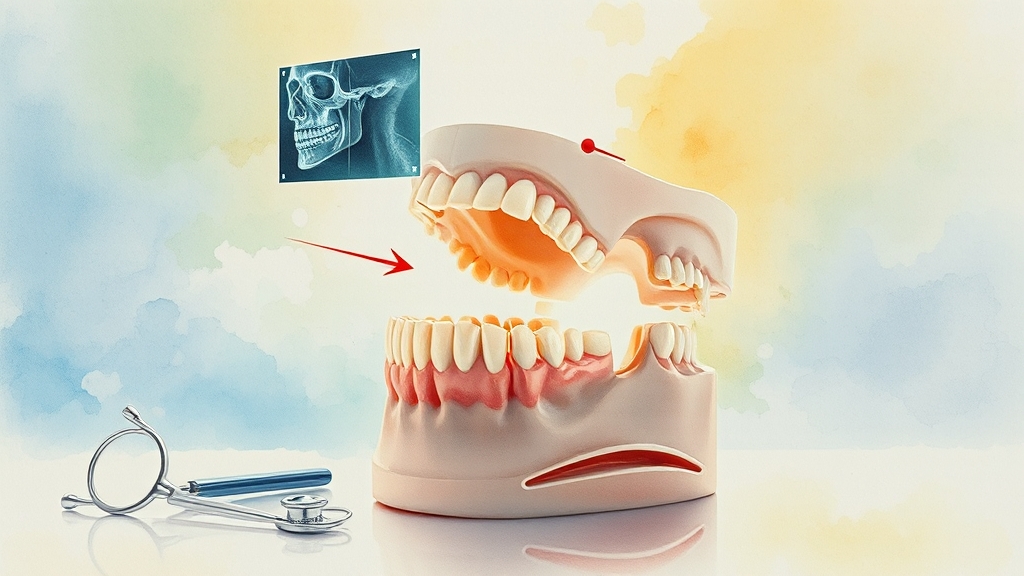
Struggling with jaw pain? You’re not alone—and it can seriously mess with your day. This guide breaks down everything from the root causes to treatments and prevention so you can protect your jaw health and get back to feeling good.
Jaw Pain: What Really Causes It

Why does jaw pain happen? There isn’t just one reason—several body factors can combine and trigger discomfort. Let’s dig into the most common causes so you can spot what’s behind yours.
Stress & Jaw Pain
Stress is a top trigger. When tension spikes, you may clench your teeth or tighten your jaw muscles without noticing. That muscle tension strains the TMJ (temporomandibular joint) and can lead straight to pain.
Lifestyle Habits That Hurt Your Jaw
Daily habits matter. Propping your chin, chewing on just one side, or sleeping on your stomach can all overload the joint. Long hours on a phone with your head tilted down also stiffen surrounding muscles and spark pain.
Dental Issues
Dental problems can be a root cause. Malocclusion (improper bite) throws the joint off balance. Impacted wisdom teeth can also irritate nearby teeth and gums, leading to jaw pain.
Issues Inside the TMJ Itself
Structural problems within the joint—like a displaced disc, inflammation, or trauma—can all trigger pain. If you hear clicks or feel discomfort when opening your mouth, a TMJ issue is likely.
Symptoms of Other Conditions
Sometimes jaw pain is a sign of something else—like salivary gland infections, parotitis, or even heart-related pain. If jaw pain comes with other symptoms, get a medical evaluation for an accurate diagnosis.
Self-Check: Do You Have Jaw Pain?

Jaw pain shows up in different ways and can spread across a wide area. If anything below sounds familiar, it’s worth paying attention to your jaw health.
Key Symptoms to Watch
Clicks when opening/closing, a “caught” or gritty feeling, trouble opening wide for eating or yawning, and muscle soreness or aching around the joint are all common signs.
How to Self-Check
Open and close your mouth: do you feel pain or hear sounds? How wide can you open? Observe your jaw movement in a mirror—any deviation or stiffness? These checks can help you gauge your status.
Why a Clinic Visit Matters
Self-checks have limits. If symptoms are severe or don’t improve with home care, see a professional for a precise diagnosis. Without timely treatment, jaw issues can become chronic.
TMJ Disorder: Definition & Diagnosis
TMJ disorders cover a wide range of symptoms across the jaw, face, and head. They occur when there’s dysfunction in the joint or surrounding muscles/ligaments. Here’s how doctors define, spot, and diagnose it.
Common TMJ Symptoms
Clicking sounds are the most common sign. You might hear a “pop” when opening/closing or a gritty, sand-like noise. Pain with movement and difficulty opening wide are also frequent complaints.
Pain Areas & Associated Symptoms
Pain often starts in front of the ear or at the temples and can radiate to the neck and shoulders. Headaches, facial muscle tension, tinnitus, and dizziness may occur. Chewing fatigue is common, too.
How Doctors Diagnose TMJ Disorders
A full workup includes listening to your symptoms and targeted exams. Doctors assess pain points, opening distance, jaw movement, and muscle tenderness to pinpoint the problem.
Imaging Matters
Imaging helps reveal structural issues. X-rays, CT scans, and MRIs can evaluate the joint. MRI, in particular, shows disc position and cartilage status—key for uncovering causes and planning treatment.
Treatments That Help Relieve Jaw Pain

Jaw pain has many causes—so treatment should match the reason. Here are options that commonly help.
Self-Care You Can Start Now
Gentle jaw stretches improve mobility and ease tension. Massage can relax overworked muscles. Keep good posture and manage stress—these two alone can make a big difference.
In-Clinic Treatments
Clinics may use relaxation therapy, physical therapy, and medications. In severe cases, surgical options are considered. Manual therapy (e.g., myofascial release) and warm compresses can help ease muscle tightness.
How Botox May Help
Botox relaxes overactive jaw muscles and can reduce TMJ pain—especially for heavy clenching or hypertrophic masseters. Results typically last 3–6 months, and pairing with habit change or orthodontic care can improve outcomes.
Nonsurgical First
Most TMJ issues respond to nonsurgical care: lifestyle adjustments, orthodontic correction for malocclusion, physical therapy, medications, and custom splints/night guards.
Preventing & Managing Jaw Pain Daily
Let’s keep jaw pain from coming back. Small daily habits can protect your TMJ and keep you comfortable.
Posture Basics
Avoid propping your chin or crossing one leg over the other for long periods—both can shift alignment and strain the TMJ. Keep screens at eye level to prevent forward-head posture.
Smarter Eating Habits
Chew on both sides, skip overly hard or chewy foods, and favor softer textures when you’re sore. Slow, mindful chewing reduces muscle load.
De-Stress Your Jaw
Stress tightens jaw muscles. Try meditation, yoga, light walks, or a warm shower before bed. Gentle relaxation routines can calm the system and protect your TMJ.
Don’t Skip Dental Checkups
Regular dental visits help catch issues early. TMJ disorders respond best to prompt care—if something feels off, book a professional evaluation.
Extra Things to Consider

Unexpected factors can also trigger jaw pain. TMJ discomfort may reflect conditions like heart issues, parotitis, sialadenitis, or inflamed wisdom teeth. Keep these in mind when evaluating symptoms.
Medical Conditions & Jaw Pain
Silent angina (without chest pain) can be up to eight times more likely to present as left-sided jaw pain. Left-side sinusitis can also radiate pain into the cheek and jaw.
Everyday Triggers to Avoid
Big yawns or wide laughter can overstretch the joint. Even massage can hurt if pressure is too strong—work with a professional and adjust intensity as needed.
Habits That Prevent Relapse
Bruxism (grinding), one-side chewing, and stress are big relapse drivers. Build stress-relief routines (meditation, yoga, relaxation drills) and work on breaking unconscious clenching or grinding.
Real-World Cases

Here are a few examples to show how causes and treatments can vary—and what it takes to prevent flare-ups long-term.
Stress-Driven Jaw Pain
A patient in their 40s had left-side jaw pain tied to stress. After treatment, their mouth opening returned to normal. With ongoing habit changes, they’re keeping symptoms from returning.
Jaw Pain with Facial Asymmetry
Another patient improved with a splint and manual therapy. Treatment plans differ by person—because causes do, too.
It’s Not Always “Just the Jaw”
Neck problems can shift joint position; stress and posture can aggravate pain; even organ function issues may contribute to chronic jaw tension.
Don’t ignore jaw pain as “temporary.” Break relapse patterns—grinding, one-side chewing, stress—and keep working steadily on jaw health.
Wrap-Up
We covered causes, symptoms, treatments, and daily prevention. Jaw pain has many triggers, but with consistent care and the right plan, it’s very manageable. Build healthy habits—and if pain persists, see a specialist for a tailored diagnosis and treatment. Here’s to a healthy jaw and bigger smiles ahead.
FAQs
What’s the most common cause of jaw pain?
Stress is one of the biggest culprits. It often leads to clenching and muscle tension, which overloads the TMJ and causes pain.
How can I self-check at home?
Listen for clicks, note any pain when opening/closing, and see how wide you can open. Watching your jaw move in a mirror can also reveal deviations or stiffness.
What are the hallmark symptoms of TMJ disorders?
Clicking sounds, pain with jaw movement, and difficulty opening wide. Headaches, facial tension, tinnitus, and dizziness may show up as well.
What self-care helps relieve jaw pain?
Jaw stretches, massage, good posture, and stress management are key. A custom splint may help prevent grinding if needed.
How do I prevent jaw pain long-term?
Maintain good posture, chew on both sides, avoid overly hard foods, manage stress, and keep up with regular dental checkups.

0 댓글